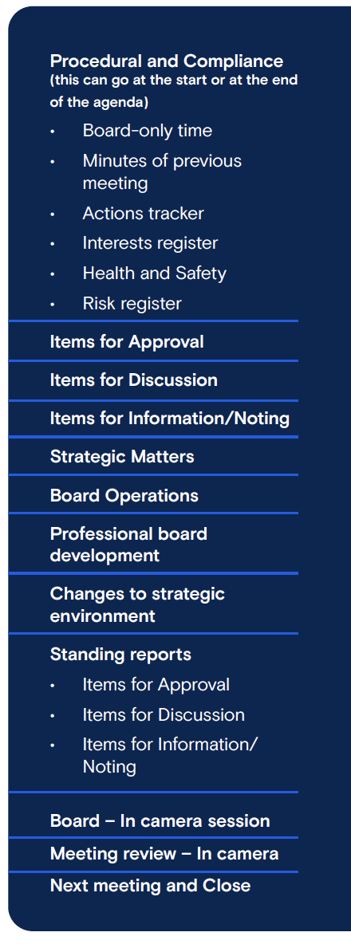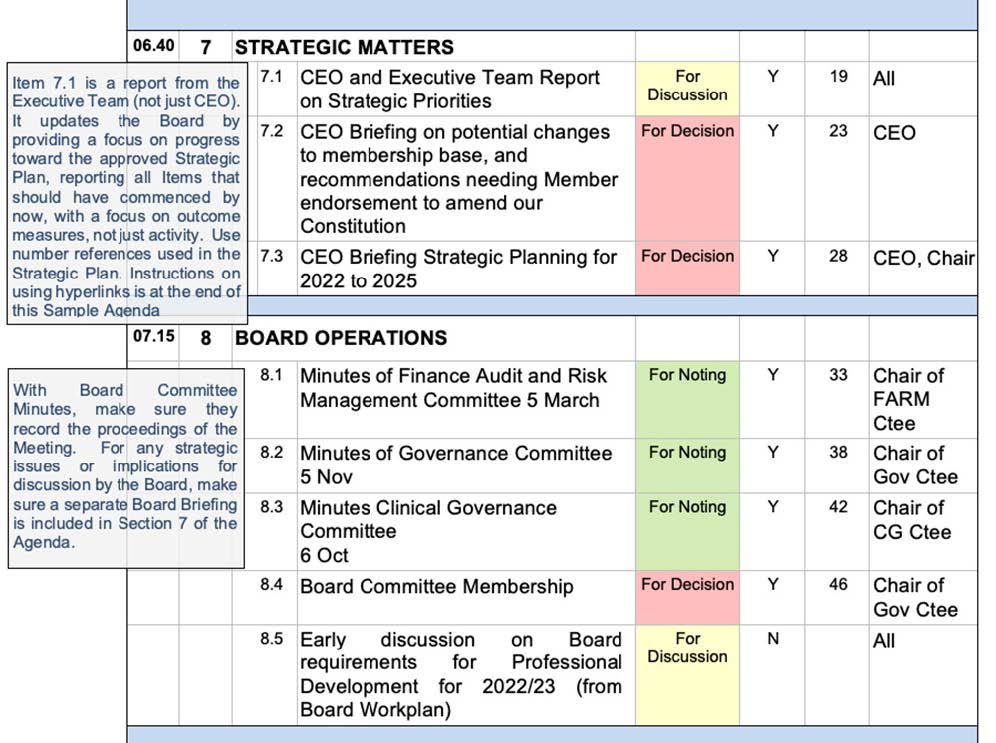Written by: Jo Kelly
 Jo Kelly is a highly experienced Company Secretary who has worked across a range of industries including private companies, publicly listed companies, public-sector, not-for-profits, and several of New Zealand’s largest major sporting events. Jo is also a Director of University and Tertiary Sport New Zealand (UTSNZ).
Jo Kelly is a highly experienced Company Secretary who has worked across a range of industries including private companies, publicly listed companies, public-sector, not-for-profits, and several of New Zealand’s largest major sporting events. Jo is also a Director of University and Tertiary Sport New Zealand (UTSNZ).
A CEO should inform the board of anything and everything that the board asks to be told, along with everything that the CEO believes the board should be told.
Directors have certain legislative rights through the Companies Act 1993 in respect of carrying out their role. Included in these is the right to receive all internal information concerning the company’s affairs, provided that such information is to be used for proper purpose. While not spelt out in law there is the assumption that, conversely, the CEO does not have the right to withhold information from directors when such information is required for the exercise of the directors’ overall responsibilities and, in particular, their duty of care.
Purposeful inquiry is certainly one of a director’s primary skills and tools; however, in exercising this, they should ensure that the purpose of their inquiry is to better meet their governance duties rather than to merely engage in trivial dialogue.
This article covers the following:
Ten more tips for producing better board papers
The quality of board papers can have a strong influence on the efficiency and effectiveness of the board. The content of board papers can be enhanced by a dynamic of trust and confidence between the chair and CEO. A chair should expect that the CEO will identify and prioritise the right topics for the board. Both parties should maintain a dialogue about the board papers including feedback on areas that need improvement and those that work well.
1. Write for your reader
Where possible, try using graphic and tabulated material for easy reference. Dashboard reporting can distil complex information into more accessible summaries. The appendix can be used to park relevant but low-priority reference detail. Bullet points can avoid lengthy sentences.

Jargon, if it needs to be used, should always be spelled out in full before an acronym or abbreviated term is used. When writing your report, apply the lens of a potential investor or total outsider to your organisation – would they understand what’s being communicated here? If no, go back and add all the relevant context to ensure it’s appropriate for its audience. Board papers are not just for the board’s benefit at one point in time. Board packs are used to gain further investment in the organisation, to assist in inducting new board members, and for your board to refer back to for various reasons at a later date. Jargon and acronyms should also be consistent across the organisation. We want all managers to be using the same acronyms and technical terms throughout the different board reports.
Remember that a non-executive director might attend a handful of meetings per year; therefore, the context and background to the paper is important. Include ‘reminder’ detail as appropriate. Avoid the risk of assuming the reader knows what you know.
When writing a board report, ask yourself: who is reading this, for what purpose, and what information do they need?
2. Align content with strategy
The board considers strategy and risk. It uses the organisation’s strategic plan to frame its thinking. It is therefore useful to point out where a proposal or project aligns with the strategic intent of the board. For example:
"......Approval of a new employee share scheme is a step forward for the company by increasing the monitoring capability. This aligns with the strategic goal for 2023 to improve monitoring of staff training and performance."
Jo Kelly - CEO Independent Governance Services
3. Agenda organisation and structure
It is essential to always have in mind the role of the board - to set strategy, manage risk and hold the CEO to account. Ultimately the board is accountable to the organisation’s shareholders (or stakeholders).
The impact of board papers on meetings and decision-making is often overlooked. A focused agenda is the framework for a focused meeting.
A best-practice governance agenda should be structured as follows:

Strategic Board Agenda Template

It’s easy to overlook the importance that your agenda can play in board meetings. More than just an abc of discussion topics, the meeting agenda is crucial to keeping your board focussed, as well as reducing unnecessary papers and information being given to your board. Each year, on average you’ve got less than 12 opportunities for the board to meet for discussion. Make the most of their time, and yours, by downloading this strategic meeting agenda template and guide now.
The detailed agenda template by Conscious Governance gives you the what of agenda templates in editable Microsoft Word form. In the same document, the guide provides you with the why. So, what does this template and guide show you?
- How to structure your agenda for the best meeting flow. E.g. when to confirm minutes, review actions or raise strategic items
- Which agenda items and papers are typically for decision, for discussion, or for noting. E.g. standing reports are always for noting
- Which papers to include for fruitful board discussion. E.g. open the Strategic Matters discussion with a CEO and Executive Team report on strategic priorities
4. Timeliness
It is critical that board papers are delivered to board members on time. Five working days should be the target. If you have issues with certain managers submitting reports late, don’t hold up the distribution of the board pack; instead, send these reports out as late items. Often this is sufficiently embarrassing enough for that manager to bring them into line with due dates in the future, but if not, your board should be considering whether there are other issues at play.
For example: lack of a high-performance team culture; are the meetings scheduled too close to the end of a reporting period, making it difficult for the CFO to finalise reporting in time; or does management simply not understand the role of the board and the why behind strong board reporting and governance - perhaps they just have to be educated about the value that can exist in this process. (People need to understand why they are being asked to do this in order to do it well.)
5. Correctly classify your reports
Items for Approval
A paper that contains a decision for the board to consider should be spelled out essentially with all the hallmarks of a business case. You are asking your board to make an investment (people’s time, money, etc.) and this should be made on a sound basis. Pre-empt what your board members will want to know. Always include a very clear recommendation (or set of recommendations) outlining exactly what you’re asking them to approve.
Items for Discussion
A paper that presents at least one important item the board should discuss (e.g. introducing a new/transformative idea or revenue stream; exploring options for a future investment) should provide clear direction to the board as to what should be discussed (from the manager’s/writer’s perspective). It should include a section identifying key questions or issues for the board to consider and provide feedback or specific direction on these. Often these papers will cover an item which will then lead to a future paper that is required for a decision. The board is responsible for strategy and risk and your board usually has specialised or expert knowledge. Giving guidance to your board about the discussion required will help to ensure you’re getting the most value from your board and board meetings.
Include a dashboard tracking the organisation’s achievement of its key performance indicators (KPIs) or objectives and key results (OKRs) and other strategic initiatives. If there are no KPIs/OKRs set (and this is seen more often than you’d think), undertake strategic planning, starting with identifying the organisation’s vision, mission and purpose, as well as its core values, and then work on a strategic plan that aligns with these elements.
Items for Noting
Boards tend to spend too much time receiving verbal updates or a summary of the information contained in reports which are merely for information. These items should come last to assist in the directors avoiding spending valuable meeting time on matters which should simply be taken as read. Board members may still ask questions about the information in these reports if they have any, but by allocating limited time to these items you ensure the focus of board time is on the more important matters for that particular meeting.
6. Use of a ‘business case’ for material decisions
Items for decision should include a substantive business case, noting the need for the decision in the first place, all the relevant parameters to consider and, crucially, a clearly worded recommendation for the board to (hopefully) approve. Recommendations should also be linked to the organisation’s strategy.
Executives often forget to include all the relevant information, or they include additional unnecessary detail, making their reports less meaningful. The board secretary can quickly edit reports from an independent perspective, in collaboration with the author, to achieve useful reports that in turn stimulate quality analysis and discussion by board directors.
7. Too much or too little information
Board Papers - Make each board report clear, concise and obvious as to what you expect from the reader/board. Label each paper as For Approval/Decision, Discussion, or For Information.
Financial Reporting – not just the numbers, but always include analysis (ratios, margins), tracked over time and/or compared with relevant prior periods, and what the trends in these figures are telling you. Always include P&L, Balance Sheet and Cashflow (forward forecast).
Fiduciary and other legal duties of Directors - duties of directors should be considered by management when preparing reports. You should pre-empt your board’s questions/compliance requirements and address these things in the board reports – things like material financial decisions needs to be analysed (e.g. for solvency, preparing resolutions for major transactions, etc)
Health and Safety - Reports should be a standing agenda/board reporting item. A good board secretary should be able to give high-level advice on what sorts of matters boards need to be aware of and giving consideration to. This is often underestimated and Directors in general are not sufficiently educated around H&S. Don’t forget, this includes mental health and wellbeing, not just physical aspects.
The same goes for the Risk Register – risk management oversight and direction is an important governance function.
8. Include supporting documentation
A succinct, concise paper with plenty of thought in preparation is a winning document. Don’t be afraid to delete unnecessary operational detail if the paper calls for a strategic decision. Avoid the temptation to think ‘more always means better’. Boards usually have limited time to discuss your paper so presenting the key issues is important. Make it clear that further supporting information is available if appropriate. If a director wants greater detail, they will seek it out.
Attach larger/background information/documents as appendices to reports or bundle these together at the end of the board pack and cross-reference them within your board report. These are essentially for information only and you don’t want to clog up a board report with too much detail, making it sometimes difficult for the board to clearly decipher its key messages. Attachments and appendices are your best friend, and your board will love you for this.
Actions trackers should be used for the board’s easy reference to items they’ve requested or are expecting to make a decision on in due course, etc. Tracking these in a register which references back to the minutes and assigning owners and due dates for completion will ensure the board is performing its core monitoring and accountability role. This type of supporting documentation is an absolute must for your board.
9. Simplify and Justify
Keep board papers concise, accurate and relevant. Writing factually and objectively can be a real challenge when you are close to the subject matter, but doing so will give the board a more balanced viewpoint from which to consider your points.
There’s real value in revisiting your paper with a critical eye. Sometimes a paper left for 24 hours takes on a whole new dimension.
Peer review and commentary provide a valuable feedback loop, especially if it is a large paper. A new pair of eyes reads to comprehend (and not justify) what has been written. Peers and editors can make major contributions by offering ways to drive more sense from a sentence.
10. Focus on the forward view
A board should only be interested in historical information to help set the context. What they really want to know is what the outlook is.
It is with this forward-looking information that a board can aim to make the most effective strategic decisions for the organisation. This is why they need around a week with the board papers ahead of the meeting, to ensure sufficient reflection and time for strategic thinking.
Interested in exploring paperless portal options for your company?
Schedule a demo with our team today and begin to experience a whole new way of meeting.
Summarise:
Share this
You May Also Like
These Related Stories
%20(1).png)
10 tips for better board papers

How to Build a Better Board Meeting Pack
%20(1).png)


